#litoptern
Explore tagged Tumblr posts
Text

Southernmost record of Megadolodus (Litopterna, Proterotheriidae, Megadolodinae) from the late Middle Miocene of Fitzcarrald, Peruvian Amazonia, and mesowear analysis of diet in megadolodine litopterns
Wilson, Carillo, et al.
ABSTRACT
Megadolodinae is a clade of tropical bunodont litopterns that includes three previously recognized species from Miocene fossil sites from northern South America. Here, we report an additional occurrence of Megadolodus molariformis from the Middle Miocene exposures at the Fitzcarrald arch (Peruvian Amazonia), based on dental material, which represents the southernmost record of the clade. This discovery further increases the faunal similarity between Fitzcarrald and the coeval La Venta fauna of Colombia. Given the convergent evolution of the bunodont dentition of megadolodines with suoids (Old World pigs and New World peccaries), we tested the hypothesis of frugivory in megadolodines with a mesowear angle approach using modern pigs and peccaries. These analyses differentiate the diet of modern suoids and suggest that megadolodines had a more abrasive diet than most of these taxa, except for the grazing warthogs. The dentition of megadolodines shows similar levels of abrasion to modern babirusas, thereby suggesting that the latter may represent an appropriate modern analog.
Read the paper here:
Full article: Southernmost record of Megadolodus (Litopterna, Proterotheriidae, Megadolodinae) from the late Middle Miocene of Fitzcarrald, Peruvian Amazonia, and mesowear analysis of diet in megadolodine litopterns
39 notes
·
View notes
Text
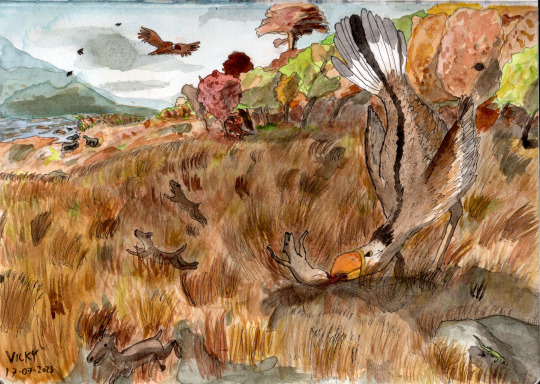
On the edge of a Miocene South American grassland, a group of Thoatherium is ambushed by a Phorusrhacos. They scatter, but the terror bird catches one of the litopterns, lifts it high up into the air, and SLAMS it down on the ground to kill it. Other nearby animals have mixed feelings about this situation. Tupinambis flees for its life, while Dryornis flies a little closer in case it can have a bit for itself. Hapalops and Astrapotherium are unbothered and have business of their own to take care of.
#phorusrhacos#thoatherium#terror bird#phorusrhacid#litoptern#cariamiform#bird#mammal#santa cruz formation#miocene#neogene#south america#autumn#tupinambis#lizard#squamate#dryornis#new world vulture#accipitriform#hapalops#ground sloth#pilosan#astrapotherium#astrapothere#my art#paleoart#palaeoblr#cw: animal death#cw: blood
78 notes
·
View notes
Text

"Naive Dragon"
a little shape and color experiment.
Fountain pen illustration + digital editing
1 note
·
View note
Text
It's time for a little bit more recent PBS Eons work this week:


• The metatherian predator Arctodictis and the litoptern ungulate Thoatherium from "The Mystery of South America's False Horses"
youtube
———
NixIllustration.com | Tumblr | Patreon
#science illustration#paleon#paleoart#palaeoblr#pbs eons#video#arctodictis#borhyaenidae#aparassodonta#metatheria#thoatherium#proterotheriidae#litopterna#meridiungulata#south american native ungulates#ungulate#mammal#art#youtube#Youtube
478 notes
·
View notes
Text


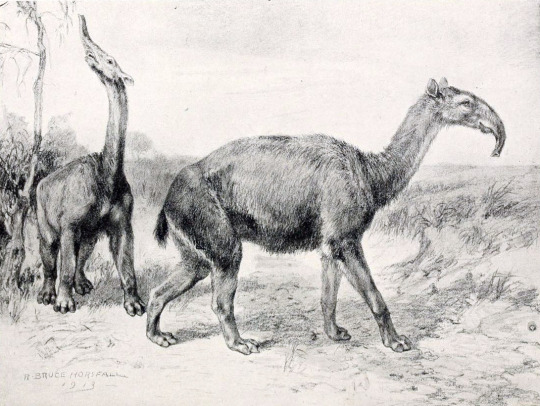
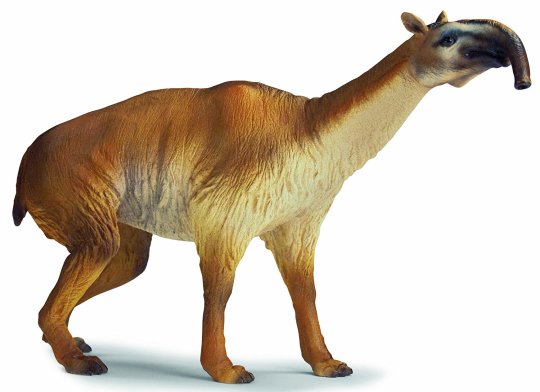
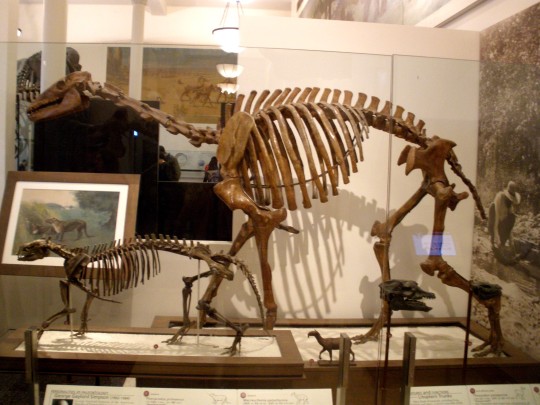

Macrauchenia
(temporal range: 7-0.01 mio. years ago)
[text from the Wikipedia article, see also link above]
Macrauchenia ("long llama", based on the now-invalid llama genus, Auchenia, from Greek "big neck") was a large, long-necked and long-limbed, three-toed native South American ungulate in the order Litopterna.[1] The genus gives its name to its family, the Macraucheniidae or "robust litopterns". Like other litopterns, it is most closely related to the odd-toed ungulates (Perissodactyla), from which litopterns diverged approximately 66 million years ago. The oldest fossils in the genus date to the late Miocene, around seven million years ago, and M. patachonica disappears from the fossil record during the late Pleistocene, around 20,000-10,000 years ago. M. patachonica is one of the last and best known member of the family and is known primarily from the Luján Formation in Argentina, but is known from localities across southern South America. Another genus of macraucheniid Xenorhinotherium was present in northeast Brazil and Venezuela during the Late Pleistocene. The type specimen was discovered by Charles Darwin during the voyage of the Beagle. In life, Macrauchenia may have resembled a humpless camel, though the two taxa are not closely related.[2] It fed on plants in a variety of environments across what is now South America. Among the species described, M. patachonica and M. ullomensis are considered valid; M. boliviensis is considered a nomen dubium; and M. antiqua (or M. antiquus) has been moved to the genus Promacrauchenia.
7 notes
·
View notes
Text
Rude grass ecology (AESL spec evo)


Rude grass heavily effects places where it grows. It is tall , growths closely to each other and hard to digest for most herbivores. It's spikes cause irritation or even allergic reaction in some animals , which while not deadly can make animal's life much harder. Places where rude grass growths are poor in diversity of other plants as they monopolise soil and sunlight by growing close to each other and being tall. Growthes of rude grass are called "Rude lands" or "Grass forests". Rude grass is highly resistant to dry and cold climate which made them widespread in north and central steppe of LoLT. It also helps in dominating other plants , as they are mostly unaffected by winter. Medium sized herbivores are abscent in such places as they are vulnerable to rude grass spikes while also lacking ability to feed on it. Only tortusole seems an exception to the rule as their armoured body protects them from getting allergic to rude grass. Tortusoles found here feed mostly on roots (of rude grass included) , mushrooms , dead and rotten parts of rude grass and small animals like insects. Tortusole seem to thrive in both non and rude grass places , using different feeding tactics to sustain itself. Huge herbivores like Sailamas and Watcher sloths can feed on rude grass using huge complex stomaches and thick lips with strong teeth to process it. Generally huge size helps to minimize effects of rude grass spikes. Some small or fossorial animals can thrive here without problems as rude grass can hide them from potential predators while not effecting them negatively due to different reasons (like living most of the time underground). Grasudents are especially common in "Rude lands" because of their small height , generalist diet and lizard like movement which help to efficiently move between tall grass. Small litopterns , lizards and flying insects are usually doing very good here. However the fact that Sailama and Watcher sloth reduce it's numbers in steppe , allowing more biodiversity of plants and animals. Medium sized predators like stepclaw and bright-beaked dragons thrive here , as open spaces are their speciality. Small animals are less common due to bigger pressure from mesopredators. With only the fittest ones surviving. Termites and ants prefer places with low density of rude grass for unknown reasons. But perhaps , diversity of biological material is a factor which plays important role here. Therefore colossal steppe anteater is only found in more open spaces , with high numbers of termite/ant nests. Giant steprunners are only found in open terrains with low numbers of rude grass , as even if they are huge themself they cannot live in "Grass forests" due to specialisations in feeding on different more softer grasses. They also cannot utilize their speed here due to lack of space , which is their main defensive mechanism. Medium sized herbivores like prokin , seekar and spooktak are thriving in places without rude grass. Due to preferences in food and that contact with rude grass can negatively effect their health. Rude grass have become much more widespread in last few thousand years due to rapid extinction of giant dicraeosaurid Stepweller. Stepweller seem to have been the most important factor in keeping rude grass under control. Their huge size , wide mouths with hardened lips and enormous stomaches were ideal to deal with tough spiky leaves and trunks of rude grass. Stepwellers feeding tactic was different from sailamas or watcher sloths , they start to eat from below which always ended in grass falling to ground. In such way plant was definently dead and uneaten by stepweller parts could be easily utilized by smaller herbivores or be rot , giving material for new plants to grow. P.S. rude grass expansion doesn't apply to south steppe or territories near rivers , as rude grass doesn't like when it is hot or wet.
6 notes
·
View notes
Text
Xenorhinotherium

Xenorhinotherium with a saiga-like nose. Cave paintings from Colombia depict a trunked ungulate, and since Xenorhinotherium fossils were found here, this could possibly be cave art of this lesser known litoptern. Though it could likely have had a moose-like snout, akin to what we believe Macrauchenia looks like.
1 note
·
View note
Photo


The mammal fossils from Bretlan, with a particularly South American flair. They’re practically unchanged from their earlier iteration only now they are Ice type, instead of Rock. There was (and still is) a lot of Rock types in Bretlan so this change helps rein them in a little and only coincidentally bolsters the numbers of one of my favourite types. Slowth are lazy pokemon. They wander aimlessly as they search for browsing and can meander for weeks at a shuffling speed before reaching their destination, somewhere that may have been visible since they started. Slowth are surprisingly capable of defending themselves if given the time they need to react, slashing with their claws or burrowing out of danger. Nothrold are somewhat more active than Slowth but remain very slow and deliberate. Their thick fur might seem like a hindrance in the warmer climes they call home but because they exert themselves so little the heat they radiate is only minor. Quite aggressive when attacked they are stalwart defenders and aren't slouches when it comes to dealing damage with their large claws. In their native lands their pelt was sometimes used to craft armour though would be too warm for any active task. Litlittle are fast young pokemon watched constantly by vigilant adult Macralap. Great herds once roamed the land but they became extinct when new predators migrated onto their continent and began hunting them fiercely. Despite being largely defenceless, Litlittle can give strong kicks although would prefer to run away (and at considerable speed too) or seek shelter among the herd. Macralap have excellent speed and endurance, allowing them to outpace all but the most determined predators. They are particularly good at turning and dodging and amongst the anonymity of the herd are difficult to single out and run down. No modern pokemon has any close relation to these pokemon but they are popular fossil pokemon to resurrect as they are excellently adapted pack-animals and very friendly. --Ability Index-- --Attack Index--
#bretlan#fakemon#fakedex#saucylobster#fossils#machrauchenia#litoptern#sloth#megatherium#nothropus#ground sloth#fossil pokemon
14 notes
·
View notes
Text


#Archovember Day 12 - Sebecus icaeorhinus
The wolf-like Sebecus icaeorhinus was a crocodylomorph from the Eocene of South America. It is the type species of the carnivorous, terrestrial Sebecosuchians, and named after the ancient Egyptian crocodile god Sobek.
Sebecus lived in a diverse South American ecosystem. It would have lived alongside Phorusrhacids (“terror birds”) and other birds, caimans, Astrapotheres, notoungulates such as Cochilius, notohippids such as Eomorphippus, litopterns like Theosodon, armadillos like Peltephilus and glyptodonts like Propalaehoplophorus, metatherians like Borhyaena and Cladosictis, monkeys, bats, snakes, frogs, turtles, and much more.
While not quite large enough to take on the giant tapir-like Astrapotheres, Sebecus was probably quite capable of preying on animals similar to its own size. With its extra strong jaw closing muscles and serrated teeth, it was likely adept at crunching through the hides and even bones of more armoured animals.
22 notes
·
View notes
Link

Research using ancient DNA has allowed a team of scientists led by Museum Curator Ross MacPhee to firmly establish the relationships of one of the strangest mammals in the known South American fossil record. Their study of this unusual species, Macrauchenia patachonica, was published today in the journal Nature Communications.
“Macrauchenia was the last of its kind, part of a hugely successful group of ungulates that had ranged over much of South America for tens of millions of years. One of its early relatives even made it to what is now part of Antarctica,” says MacPhee.
Weighing as much as 1,100 pounds, Macrauchenia patachonica was long-necked, with a body shape vaguely reminiscent of a camel’s. Its most distinguishing trait was its weirdly placed nasal opening, situated high on the skull, between the eye sockets. To some scientists, this feature suggested an elephant-like trunk.
Since morphology hadn’t solved the riddle of Macrauchenia’s relationships, the team came up with the solution of using ancient mitochondrial DNA, extracted from an 11,000-year-old Macrauchenia fossil found in a cave in southern Chile...
illustrations: T - Olllga | Wikimedia and B - Robert Bruce Horsfall
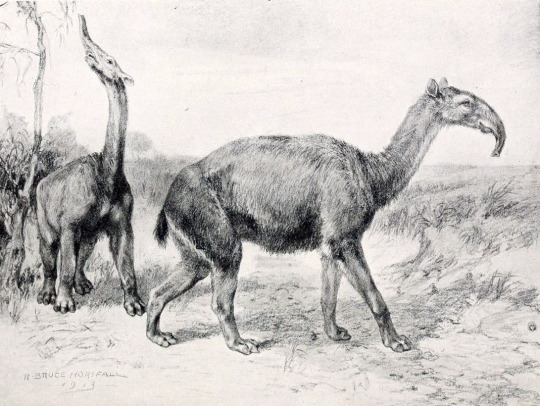
#south america#illustration#prehistoric#macrauchenia#mammal#evolution#animals#science#DNA#genetics#litoptern
503 notes
·
View notes
Text
Oh to be a sebecosuchian, wandering the grasslands of Oligocene south america, stalking notoungulates and litopterns....
2 notes
·
View notes
Note
How did the meridiungulates make it to South America in the Paleocene? I heard they island-hopped there from North America, but how come they were the only ones?
The North America hypothesis is based on two things: the proteomic evidence that meridiungulates are stem-perissodactyls, and anatomical similarities between litoptern and “mioclaenid” teeth. “Mioclaenids” are found in North America, Europe, and South America. One phylogenetic analysis with mostly tooth characters shows a grade of “mioclaenids” leading to litopterns and “didolodontids” (with the South American mioclaenids being the closest). The positioning of “mioclaenids” has not yet been evaluated taking the meridiungulates-are-perissodactyls evidence into account, though.
As for why they were the only mammals to come from North America, when primates, rodents and bats came to South America from Africa - I have no idea.
15 notes
·
View notes
Photo

While this animal might look like some sort of deer or horse, it was actually only distantly related to any modern hoofed mammals.
This is Thoatherium from the Early Miocene (~17-16 mya) of Argentina. About 70cm long (2′3″), it was related to the weird llama-like Macrauchenia and was part of an extinct group of ungulates (the Meridiungulata) which evolved during South America’s time as an isolated island continent.
It was adapted for fast running, with long legs and only a single horse-like hoof on each foot -- but it was even more one-toed than modern horses are, having no remaining “splint bones” from vestigial side toes.
#science illustration#paleontology#paleoart#palaeoblr#thoatherium#litoptern#meridiungulata#mesaxonia#ungulate#mammal#south america#convergent evolution#art#south american weirdness#small cute horse-mimic -- so it's basically a fossil my little pony
317 notes
·
View notes
Photo

It was so difficult for me to not put the trunk on. Litopterns have certainly lost something. Anyway X is for... #xenorhinotherium #macrauchenia #megafauna #southamerica #venezuela #palaeontology #palaeontologist #pleistocene #pleistocenefossils #fossil #fossils #naturalhistory https://www.instagram.com/p/CE62oqGphDI/?igshid=chi71if3rckn
#xenorhinotherium#macrauchenia#megafauna#southamerica#venezuela#palaeontology#palaeontologist#pleistocene#pleistocenefossils#fossil#fossils#naturalhistory
2 notes
·
View notes
Text
Things I want from Volume 7, in no particular order:
Watts having Tyrian infiltrate a political rally and using his minority status to persuade other Faunus to vote for Jacques.
Clover asking Qrow out on a date (and Qrow saying yes).
Whitley calling Winter and Weiss in a panic begging them to come home because “Father let a strange man in the house and I’m pretty sure this guy’s mafia please come rescue me he creeps me the fuck out.”
More Grimm based on Pleistocene megafauna like mammoths, litopterns, ground sloths, and Irish elk.
Jacques promising to “Make Atlas great again.”
Tyrian stalking Jaune.
Ruby having some sort of emotional breakdown and finally processing Penny’s death, and unpacking the trauma she’s spent three volumes ignoring.
Maria doing literally anything. We stan a queen.
The group fighting over whether or not they’re hypocrites (spoiler alert: they are) about keeping secrets the same way Ozpin did.
Watts backstory.
Scenes of people in Mantle struggling due to resource shortages/scarcity.
Nora spending a lot of time in Mantle trying to help anyone who’s in need of food or shelter, because it pains her to see the poor suffering. Hopefully this will lead to backstory on her.
Klein eavesdropping on Jacques and Watts, and then trying to figure out how to relay what he overheard to Atlas’ council while protecting Whitley and Willow.
Character development for Oscar. Please. Let this kid be upset, and scared, and outraged, and guilt-ridden. Let him be angry at RWBY/JN_R/Qrow for how they’ve treated him the last few volumes. Develop his personality and give him agency.
Ozpin being furious at everyone and chewing them out for, among other things, victim-blaming him and making Really Stupid Decisions regarding the Relics.
James finally giving Ozpin that explanation he owes him back from Volume 3 (“The girl, I can explain—”). Did he use the Staff of Creation to give a soul to a synthetic person?
The kids asking about the location of the Summer Maiden. (Seriously, why do these kids never ask fucking questions.)
Qrow using his transformation for stealth or delivering messages. You’re literally a god damn bird, put that skill to use.
The kids experiencing Atlas and Mantle culture. As Orwellian as the kingdom is right now, that doesn’t mean everything in the cities came to a standstill. Have Weiss excitedly showing off her culture by dragging her friends around to restaurants and shops.
The kids having a snowball fight. Alternatively: someone builds a snowman that looks like a Grimm.
Remember that soul-transfer technology that James had his scientists (presumably Dr. Polendina) working on, that was repurposed for Amber? Can we bring that back?
Pietro and Watts interacting. I want them to have either been colleagues or friends (or husbands because why not). How cool would it be for him to find out that Watts is alive after whatever incident led to his alleged death?
The villains seizing control of Amity Colosseum and using it for kinetic bombardment (à la Sokovia), and wrecking the shit out of both Atlas and Mantle.
Alternatively: Watts hijacks the broadcast meant to reveal the existence of Salem to the world, and instead, they release a (heavily cherry-picked, defamatory) exposé about Ozpin, which highlights many of the things he’s orchestrated over the last few decades (and how, in the right light, it all looks very incriminating—the headmasters of the academies serving him, giving dangerous magic to four individuals to use as they see fit (cough, Raven and her bandits), all the general cloak and dagger). Not only does this cause global panic, but the world can no longer trust the headmasters (and by extension, any Huntsmen that studied under them) because they could have very well been recruited by Oz’s cabal. At the end of the volume, Ozpin gets what he wanted: the world united. Only this time, they’re united against him. And all the while Salem’s existence continues to remain a secret, allowing her to operate from the shadows as the manhunt for Ozpin begins.
Jacques going to jail or getting decked in the face. Preferably both, in either order.
Meeting teachers from Atlas Academy. This is a prestigious combat school staffed by trained Huntsmen. Can we please see some of them from time to time?
Robyn Hill doing savvy political stuff.
Qrow interacting with Yang and having a positive relationship with both of his nieces.
Qrow struggling with alcoholism. (Really hating the fact that he just got over it off-screen, like it wasn’t a major self-destructive coping mechanism he spent years dealing with that resulted in him hurting his family and jeopardizing their safety.)
James interacting with students on campus. I can’t get over just how much of a dad he was when he was talking to Oscar, and now I just want to see him doing that with all of his students.
The kids attending some sort of political event/party where they have to dress up and mingle with the Atlesian socialites.
#rwby#rwby thought dump#rwby volume 7#rwby vol 7#rwby spoilers#there are a million other things i want to include but this list is already way too long#my posts#i speak
26 notes
·
View notes
Link
0 notes